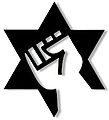- Raised fist
-
The raised fist (also known as the clenched fist) is a symbol of solidarity and support.[1] It is also used as a salute to express unity, strength, defiance, or resistance. The salute dates back to ancient Assyria as a symbol of resistance in the face of violence.[2]
Contents
History
Assyrian depictions of the goddess Ishtar show her raising a clenched fist.[3] A raised fist was used as a logo by the Industrial Workers of the World[4] in 1917. The graphic symbol was popularized in 1948 by Taller de Gráfica Popular, a print shop in Mexico that used art to advance revolutionary social causes.[5] The symbol has been picked up and incorporated around the world by various groups fighting oppression.
-
October Revolution 1922
-
Civil liberties poster 1940
-
Antifeminist resistance
-
Librarians Against DRM
-
Anti-Clipper graphic
-
Graffiti 2010
Logo
 Clenched fist symbol of the northern soul movement
Clenched fist symbol of the northern soul movement
The raised fist logo may represent unity or solidarity, generally with oppressed peoples. The black fist, also known as the Black Power fist is a logo generally associated with black nationalism and sometimes socialism. Its most widely-known usage is by the Black Panther Party in the 1960s. A black fist logo was also adopted by the northern soul music subculture. The white fist, also known as the Aryan fist or the White Power fist is a logo generally associated with white nationalism.
A white fist holding a red rose is used by the Socialist International and some socialist or social democratic parties. Loyalists in Northern Ireland occasionally use a clenched fist on murals depicting the Red Hand of Ulster. However, this is considered rare; the red hand is usually depicted with a flat palm.
Salute
The raised fist salute consists of raising one arm in the air with a clenched fist. Different movements sometimes use different terms to describe the raised fist salute: amongst communists and socialists, it is sometimes called the red salute, whereas amongst black rights activists, especially in the United States of America it has been called the Black Power salute. During the Spanish Civil War, it was sometimes known as the anti-fascist salute. The traditional version of the salute, originally a symbol of the broader workers' movement, became associated with the parties of the Comintern during the 1920s and 1930s. Since the Trotskyists were forced out of the Comintern, some Trotskyists have made a point of strictly raising the left fist in the tradition of the Left Opposition. Some anarchists also prefer the left fist to denote their libertarian socialist opposition to Marxism.
The clenched fist gesture is sometimes mistakenly thought to have originated in the Spanish Civil War, where the Popular Front salute was at one time the standard salute of Republican forces. A letter from the Spanish Civil War stated: "...the raised fist which greets you in Salud is not just a gesture—it means life and liberty being fought for and a greeting of solidarity with the democratic peoples of the world."[6]
At the 1968 Summer Olympics in Mexico City, medal winners John Carlos and Tommie Smith gave the raised fist salute during the American national anthem as a sign of black power, and as a protest on behalf of the Olympic Project for Human Rights. For this, they were banned from further Olympic activities. The event was one of the most overtly political statements[7] in the history of the modern Olympic Games. Tommie Smith stated in his autobiography, "Silent Gesture", that the salute was not a Black Power salute, but in fact a human rights salute.
A raised White fist is also a popular White Power symbol. The Rotfrontkämpferbund paramilitary organization of Communist Party of Germany used the salute before World War II.[8]
Groups that have used the symbol
- Albanian National Liberation Front
- April 6 Youth Movement
- American Indian Movement
- Anarchist Black Cross
- Black Panther Party
- Democratic Labour Party of Brazil
- Earth First!
- Women's Liberation
- Food Not Bombs
- International Brigades
- International Brotherhood of Electrical Workers
- International Socialist Organization
- Italian Radical Party
- Jewish Defense League
- Kach
- National Equality March
- Occupy Wall Street
- Otpor
- Parti Sosialis Malaysia (Socialist Party of Malaysia)
- Revolutionary Socialist Workers' Party (Turkey)
- Red Front Fighters' League
- Saor Éire (1967-1975)
- Socialist International
- Socialist Party of England and Wales
- Socialist Workers Party (Britain)
- Socialist Youth Front
- United Farm Workers
- Zimbabwe African National Union – Patriotic Front
See also
- 1968 Olympics Black Power salute
- Civil disobedience
- Far-left politics
- Lal Salam
- Protests of 1968
Notes
- ^ Every Movement Needs a Symbol: Enter The Wisconsin Fist of Solidarity
- ^ The Samuel Gray Society
- ^ http://www.samgraysociety.org/sgray/fist.html
- ^ Joyce L. Kornbluh, Solidarity, 1917; Rebel Voices: An IWW Anthology, Charles H. Kerr Publishing, 1998
- ^ Mexican posters on social and educational themes
- ^ Rolfe, Mary. Letter to Leo Hurwitz and Janey Dudley, 25 November 1938. Reprinted in Cary Nelson and Jefferson Hendricks, eds. "Madrid 1937: Letters of the Abraham Lincoln Brigade from the Spanish Civil War," Routledge: 1996. Reprinted online [1]
- ^ Lewis, Richard (2006-10-08). "Caught in Time: Black Power salute, Mexico, 1968". London: The Sunday Times. http://www.timesonline.co.uk/article/0,,2094-2393575,00.html. Retrieved 2008-11-09.
- ^ Korff, Gottfried: "Symbolgeschichte als Sozialgeschichte? Zehn vorläufige Notizen zu den Bild- und Zeichensystemen sozialer Bewegungen in Deutschland", in: Warneken, Bernd Jürgen (Hg.): "Massenmedium Strasse. Zur Kulturgeschichte der Demonstrationen." Frakfurt/Main 1991. S. 27-28. Cited in: Schulte-Rummel, Sven "Die politische Symbolik der Kommunistischen Partei Deutschlands in der Weimarer Republlik" [2]. "Im Gegensatz zu den meisten anderen Symbolen der Kommunisten beginnt die Geschichte der geballten Faust in der Ära der Weimarer Republik. Sie war prägendes Symbol bei Straßenaufmärschen, Spiegel der gewaltbereiten Demonstranten, die voller Frust über das System dem Staat die geballte Faust zeigten." Translation: "Unlikely the most of other Communists symbols, the history of Raised fist started in the era of Weimar Republic. It was a definitive symbol of street marches, reflection of the marchers who were ready for violence, who were disappointed by the whole system of the state and showed their clenched fists to it."
External links
- A brief history of the 'clenched fist' image
- Bitter price of Olympics' iconic image - from Los Angeles Daily News
- India Faces Maoist 'Red Salute' - from BBC World News
- Aryan Fist article - from the Anti-Defamation League
- Race row over 'Black Power' statue from Mail Online News
References
- ^ Every Movement Needs a Symbol: Enter The Wisconsin Fist of Solidarity
- ^ The Samuel Gray Society
- ^ http://www.samgraysociety.org/sgray/fist.html
- ^ Joyce L. Kornbluh, Solidarity, 1917; Rebel Voices: An IWW Anthology, Charles H. Kerr Publishing, 1998
- ^ Mexican posters on social and educational themes
- ^ Rolfe, Mary. Letter to Leo Hurwitz and Janey Dudley, 25 November 1938. Reprinted in Cary Nelson and Jefferson Hendricks, eds. "Madrid 1937: Letters of the Abraham Lincoln Brigade from the Spanish Civil War," Routledge: 1996. Reprinted online [1]
- ^ Lewis, Richard (2006-10-08). "Caught in Time: Black Power salute, Mexico, 1968". London: The Sunday Times. http://www.timesonline.co.uk/article/0,,2094-2393575,00.html. Retrieved 2008-11-09.
- ^ Korff, Gottfried: "Symbolgeschichte als Sozialgeschichte? Zehn vorläufige Notizen zu den Bild- und Zeichensystemen sozialer Bewegungen in Deutschland", in: Warneken, Bernd Jürgen (Hg.): "Massenmedium Strasse. Zur Kulturgeschichte der Demonstrationen." Frakfurt/Main 1991. S. 27-28. Cited in: Schulte-Rummel, Sven "Die politische Symbolik der Kommunistischen Partei Deutschlands in der Weimarer Republlik" [2]. "Im Gegensatz zu den meisten anderen Symbolen der Kommunisten beginnt die Geschichte der geballten Faust in der Ära der Weimarer Republik. Sie war prägendes Symbol bei Straßenaufmärschen, Spiegel der gewaltbereiten Demonstranten, die voller Frust über das System dem Staat die geballte Faust zeigten." Translation: "Unlikely the most of other Communists symbols, the history of Raised fist started in the era of Weimar Republic. It was a definitive symbol of street marches, reflection of the marchers who were ready for violence, who were disappointed by the whole system of the state and showed their clenched fists to it."
Gestures Friendly gestures Air kiss · A-ok · Cheek kissing · Dap greeting · Elbow bump · Eskimo kissing · Fist bump · Hat tip · High five · Hongi · ILY sign · Namaste · Sign of the horns · Shaka · Thumbs signal · WaiFormal gestures Salutes Bellamy salute · Nazi salute · Raised fist · Roman salute · Scout sign and salute · Three-finger salute · Two-finger salute · Vulcan salute · Zogist saluteCelebratory gestures Finger counting Obscene gestures Head motions Other gestures Air quotes · Anasyrma · Crossed fingers · Facepalm · Finger gun · Gang signal · Hand-rubbing · Jazz hands · Kuji-in · Laban sign · Loser · Mudra · Pollice verso · Puppy face · Shrug · Sign of the Cross · Varadamudra · V signRelated Categories:- Gestures
- Logos
Wikimedia Foundation. 2010.






















